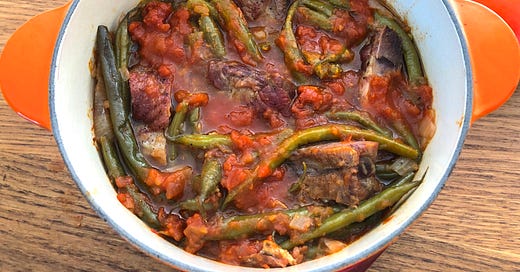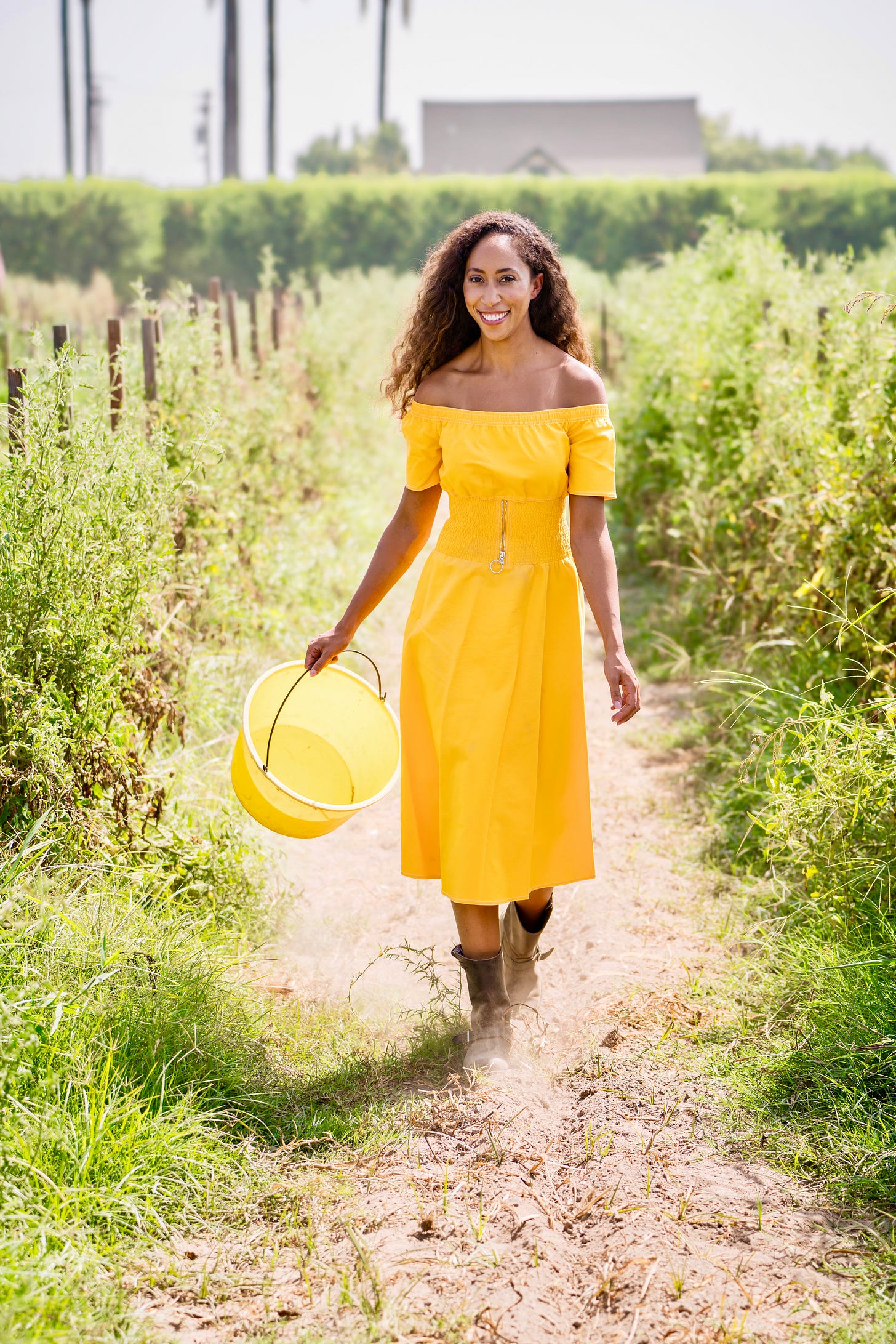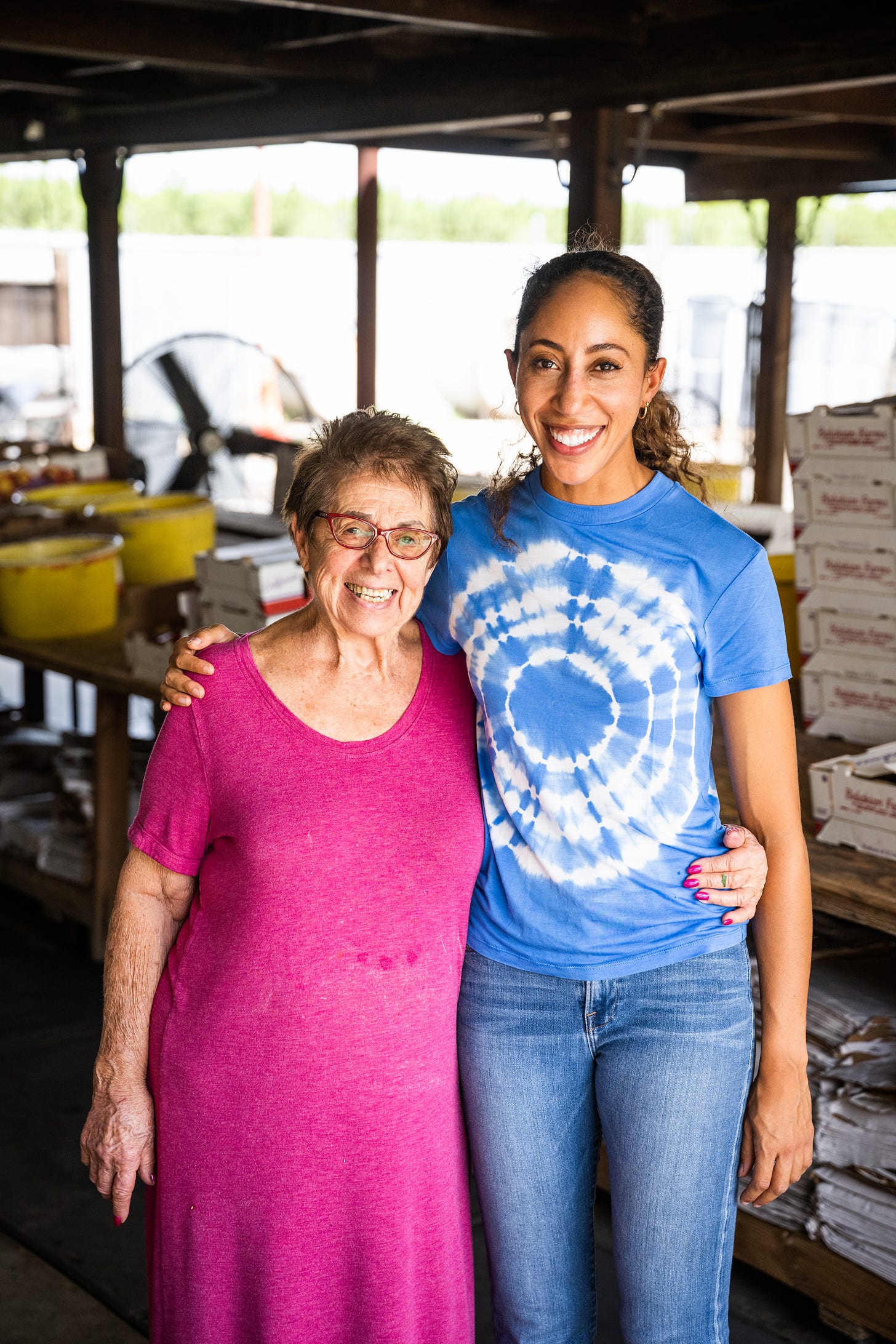Happy March! Is it really going to be spring in just a few days? It certainly doesn’t feel like it in the Bay Area, with all this cold and rain. As much as I love all the water, I’m starting to worry about my local farmers. Speaking of which:
This week’s newsletter is an interview with Amber Balakian, a fourth-generation farmer from the Central Valley. I’ve been buying Balakian Farms’ vegetables for years at farmers’ markets (I particularly like their cucumbers), so it was a treat to have the chance to hear more about this Armenian family’s history and cooking. We first spoke a couple years ago, when the family’s jarred tomatoes were just taking off, and this week I learned that I can now order them on Amazon. Amber also shared a delicious recipe for green bean and ribs stewed in tomato sauce, which she makes with these flavorful pureed tomatoes. It’s an all-in-one meal full of summery flavors that you can make any time of year—even on a stormy week like this one. (The recipe is toward the bottom of the newsletter.) Here’s our conversation, condensed and edited a bit:
Amber Balakian
Our farm was started in 1925, but my great-grandparents came over to the Central Valley area during the genocide. A lot of Armenians settled in California, primarily in L.A. and the Fresno areas. Back then, our town was predominantly German, and if you weren't German, you couldn't work in town. So, a lot of Armenians ended up settling in the country area, and that's why there's so many of them that farm today.
My great-grandparents planted grapes—Thompson grapes—to make raisins. And then my grandfather, who's the eldest of six, he got married and he bought 20 acres not too far (maybe like a 10-minute drive) from where he grew up. My grandparents started farming fruits and vegetables and took them to farmers’ markets in Northern and Southern California. My mom, Ginger, and her sister, Kathy, also helped with the farm. My mom is really the one that transitioned things to organic in the early 90s, when it wasn't that popular. We were one of the first in our area to do that.
Then we started planting heirloom tomatoes, and that really grew because those were also kind of new in the 90s. People didn't really know that much about them. At one point we had, I think, 80 varieties or more in one season (which is a lot). And we save our own seeds, too, so that definitely helps with improving the crop every year.
Now we grow both tree fruit and a lot of different types of vegetables. And, of course, the tomatoes. We go to a lot of the same markets we've been to for 30 years. We also sell to different retailers, like Bi-Rite.
I grew up on the farm, and even when I was younger, I'd go to the farmers’ markets. Our whole family would go every week and sell. After I went to college (I went away for college), I wasn't really thinking, Oh, I'm going to do this for my career. But after I graduated, I decided to come back and help my family with the management side. And I did for, like, about a year. After that, I started thinking about developing products for our farm. My grandma, Stella, is really known for her cooking. She would always use whatever we grew. People from LA, whenever they would pass through, they would stop, and she would cook for them. So, I developed the blended heirloom tomatoes in the different colors using her recipe for tomato sauce.
I started selling that and making the sauce, and we would source all the tomatoes from our farm. Shortly after that, I started teaching full-time at a local community college, so, I actually stopped doing the tomatoes for a little while. And then, just a couple years ago, we were getting a lot of calls for it, so I thought like, Okay, I've been at my job for four years, so let me start doing this again. And last year I got the Value-Added Producer Grant [from the USDA] to expand it, so that's been my project for this past year. We’ve rebranded our farm, and we're redoing the website and all of the packaging. And next year I'm going to have it manufactured. We're still going to grow the tomatoes, but we’re taking them to a facility to be processed.
I grew up with a lot of very traditional Armenian cooking. I didn't know that other people didn't eat lamb every week because I grew up with a lot of Armenian people in our lives. My grandma would can a lot. She would make tourshi, the Armenian pickles with the different vegetables, and she’d make jam to preserve whatever we had growing. She’d even make fig candy and quince candy and a lot of Armenian pastries.
We would typically have an Armenian dish every dinner, whether it was lahmajoun, shish kebob, kufta, dolma—your typical Middle Eastern-type dishes. We always had fresh vegetables, salads, things like that—especially in the summer, because of the produce that we had on hand. And everything that my grandma made was from scratch. Some people will buy, for example, the filo dough and then put in the other ingredients. She would make it from scratch. She would make her own noodles and even her spices. She learned from her mom, who was from a small town in Armenia, in a rural area. So, it was very much like a you-make-everything-yourself type of thing.
She's 92, and she still cooks every day. My mom doesn't cook, really, and my dad isn't a huge cook. His family does cook; they make very Southern, African American-style types of food—the fried catfish, chicken, greens, all of that. My aunt cooks a lot. She likes to make a lot of different things and come up with her own recipes, too. And she bakes a lot of really good desserts with fruit. And then my grandpa, he passed away some time ago, but he would barbecue. And I feel like I kind of took after him because I love to barbecue.
When I barbecue, I’m probably mixing in Armenian ways of cooking a little bit because that’s what I grew up with—I'm just kind of going off of what I was taught by my family. It could be like an Armenian way of cooking and I don't even really know it. So, if I’m cooking something, I'll have tourshi pickles with it, and then maybe, like, an Armenian salad. Even if I'm having a more American meal—like steak or something like that—there's always something Armenian in the whole mix of things. We don't eat regular bread, we eat Armenian bread—you know, the lavash bread. Or we'll make pilaf as our side. No matter what we're making, there's always like some type of Armenian influence in the meal.
Green Beans and Ribs Stewed in Tomato Sauce
This is a traditional Armenian dish that you’ll sometimes see with either just green beans and tomatoes or with a combination of green beans, tomato, and lamb. Amber’s version is made with “riblets,” the ribs (and attached meat) that butchers slice off of spareribs. If your grocery store or butcher doesn’t usually carry them, having them cut regular ribs in half, to make smaller pieces, also makes for a great version. Amber notes that you can cut the beans any size you like (or use flat Romano beans cut into bite-sized pieces). You can also add mushrooms, pieces of potato, or any other vegetables. The result is a flavorful all-in-one meal, especially if you add lavash (Armenian flatbread) or another carbohydrate, like rice.
1 to 1½ pounds riblets
Kosher salt
1 medium onion, sliced (or diced)
2 garlic cloves, sliced
1½ pounds string beans, trimmed
1 cup chicken or beef broth
1 cup tomato sauce or puree (ideally Balakian Farms blended heirloom tomatoes)
Freshly ground pepper
Put the riblets in a pot or a Dutch oven, season them with salt and add enough water to cover the meat. Bring the pot to a rolling boil, skim any foam that rises to the surface, and let the meat boil until the water evaporates; this will take somewhere around 30 minutes, depending on the size of your pot and the heat of your stove. (When the water has boiled away and all you have left is fat, the meat will start to get nicely brown on the bottom of the pan.)
Turn off the heat, then remove the riblets and set them aside, leaving the fat in the pot. (If there’s more than a thick slick of fat, remove some.)
Using the fat in the pot, sauté the onion and garlic until soft, about 3 minutes. Put the meat back into the pot and add the string beans and the broth. Bring the mixture to a boil, then add the tomato sauce.
Lower the heat and let the mixture cook slowly for 30 minutes. (If the green beans take a while to soften, you can cover the pot for a few minutes, just until the beans can be mostly submerged in the sauce, but then uncover the pot so that the liquid cooks down into a sauce.) Season with pepper and salt to taste before serving.
More California Stories to Read, Watch, and Listen To
My fun read this week was the LA Times’ package about why the city of angels is the best coffee city in the world. While I’m sure plenty of other cities would like to put up a fight for that title, the paper’s piece about coffee from China (specifically from Yunnan Province, where I used to live) had me convinced. Up here in the Bay Area, meanwhile, KQED has reported on a new farmers’ market bringing fresh produce to West Oakland.
If you’re looking for more delicious things to cook, check out Sunset Magazine’s package about chef Tanya Holland, complete with recipes from her book. Cookbook goddess Andrea Nguyen’s most recent post on her Pass the Fish Sauce newsletter also includes a delicious, comforting recipe for wonton noodle soup. Meanwhile, Edible Marin and Wine Country shared this fun, retro-feeling stuffed artichoke recipe.
Photos: Georgia Freedman, Courtesy Amber Balakian (5)









